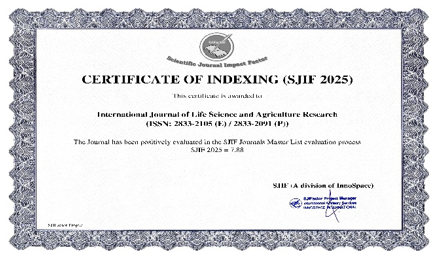The Relationship between Several Biological and Chemical Soil Properties to Maize Productivity in Kecamatan Cibugel, Kabupaten Sumedang
DOI:
https://doi.org/10.55677/ijlsar/V02I08Y2023-09Keywords:
azotobacter sp, chemical, maize, productionAbstract
Maize was a crucial staple crop and played a pivotal role in the food security. However, the productivity of maize remained insufficient to saturate the market demands. Improving maize productivity can be achieved on the available land by considering the soil characteristic. One of the impediments encountered in the challenges of maize productivity was the lack of information regarding the interaction of biological and chemical soil parameters that influenced maize productivity. This study aimed to investigate the relationship between the biological and chemical characteristics of the soil to maize productivity. The method in this study was descriptive and comparative. The methods in this study were descriptive and comparative. This study was conducted at 18 points located in Cibugel, Sumedang. The land used was a land unit sampling based on slope, elevation, climate, and maize production area. The parameters carried out in this study consist of Azotobacter sp., fungi, soil organic C, total N, and C/N ratio. Soil samples were collected using composite sampling and analyzed in the laboratory. Statistical analysis was conducted by correlation analysis using Smartstat XL and Microsoft Excel 2019. The result showed that there were correlations among various soil chemical and biological properties. Specifically, there were relationships between fungal populations with soil organic C and C/N ratio, and soil pH with total N.
References
Blanco-Canqui, H., Shapiro, C. A., Wortmann, C. S., Drijber, R. A., Mamo, M., Shaver, T. M., & Ferguson, R. B. (2013). Soil organic Carbon: The value to soil properties. Journal of Soil and Water Conservation, 68(5): 129–134.
Czaban, J., & Wróblewska, B. (2017). The effect of bentonite on the survival of azotobacter chroococcum in sandy soil in a long-term plot experiment. Polish Journal of Environmental Studies, 26(1): 1–8.
Dewi, E. K., Nuraini, Y., &; Handayanto, E. 2017. Benefits of local plant biomass to increase soil nitrogen availability in dry land of South Malang. Journal of Land and Land Resources, 1(1): 17-25.
[DTPH]. Department of Food Crops and Horticulture. 2021. Maize Harvest Area Based on Districts, Cities/Municipalities in West Java. Department of Food Crops and Horticulture, Bandung. [internet]. [Referenced 2022 September 3]. Available on https://opendata.jabarprov.go.id/.
Dwiastuti, S. (2012). Study of the contribution of earthworms and their role to the environment in relation to soil quality. In Proceedings of the Biology Seminar, 9 (1).
Gamasika, F., Yusnaini, S., &; Niswati, A. 2017. Earthworm Population and Biomass on Various Vegetation on Each Slope and Their Correlation to Soil Fertility in the Integrated Field Laboratory of the Faculty of Agriculture, University of Lampung. Journal of Tropical Agrotech, 5(3): 169-174.
Hartati, R. D., Suryaman, M., & Saepudin, A. (2023). The effect of phosphate solublizing bacteria at various soil ph on plant growth and yield of soybean (Glycine max (l.) Merr). Journal of Agrotechnology and Crop Science, 1(1): 26–34.
Herlina, N., &; Prasetyorini, A. 2020. The effect of climate change on the growing season and productivity of maize (Zea mays L.) in Malang Regency. Indonesian Journal of Agricultural Sciences, 25(1): 118-128.
Kusumawati, I. A., &; Prayogo, C. 2019. The impact of land use change in ub forest on mirkoba biomass carbon and total bacterial population. Journal of Land and Land Resources, 6(1): 1165–1172.
Mariappan, V., Karthikairaj, K., & Isaiarasu, L. (2013). Relationship between earthworm abundance and soil quality of different cultivated lands in Rajapalayam, Tamilnadu. World Applied Sciences Journal, 27(10): 1278–1281.
Nio, S. A., Rumbay, J. A., Anggini, P. S., Supit, P. S. L., & Ludong, D. P. M. 2021. The potential of sonic bloom method to enhance plant growth. Journal of Mathematics and Natural Sciences, 10(2): 76-80.
Pasaribu, P., Nirwanto, H., &; Harijani, W. S. 2019. The diversity of rhizosphere microorganisms in suppressing the level of downy mildew attack on maize plants in Jombang Regency. Agrotechnology Scientific Periodical, 7(1): 45-54.
Phillips, H. R. P., Guerra, C. A., Bartz, M. L. C., Briones, M. J. I., Brown, G., Crowther, T. W., Ferlian, O., Gongalsky, K. B., Van Den Hoogen, J., Krebs, J., Orgiazzi, A., Routh, D., Schwarz, B., Bach, E. M., Bennett, J., Brose, U., Decaëns, T., König-Ries, B., Loreau, M., … Eisenhauer, N. (2019). Global distribution of earthworm diversity. Science, 366(6464): 480–485.
Saputra, d., erlina, y., & barbara, b. 2022. Analysis of trends in maize production and consumption in Indonesia. Journal of agricultural socioeconomics, 17(1): 30-46.
Sari, R., &; Prayudyaningsih, R. 2015. Rhizobium: its utilization as a nitrogen-fixing bacterium. Ebony Bulletin, 12(1): 51-64.
Sasminto, R. A., Sutanhaji, A. T., &; Rahadi W., J. B. (2014). Spatial analysis of climate determination according to Schmidt-Ferguson and Oldeman classification in Ponorogo District. Journal of Natural Resources and the Environment, 1(1): 51–56.
Singh, J., Schädler, M., Demetrio, W., Brown, G.G., Eisenhauer, N. 2019. Climate change effects on earthworms-a review. Soil Organism. 91 :114–138.
Soil Survey Staff. 1990. Keys for Soil Taxonomy. SMSS Technical Monograph No. 19 Fourth Edition. Maizeell University.
Sri Dwiastuti, &; Suntoro. (2011). The existence of earthworms in the environment of various plant cultivation systems in calcareous land. In Proceedings of Biology Education Seminar 15:16–34
Zhang, W., Cao, J., Zhang, S., & Wang, C. (2016). Effect of earthworms and arbuscular mycorrhizal fungi on the microbial community and maize growth under salt stress. Applied Soil Ecology, 107: 214–223.












